It was a fun but busy few days testing out all the demos from Yamaha. They ended up sending a total of 31 different clubs when in fact there were only 4 new drivers and 4 new irons as well as the 1 new D Power Spoon to test. For some reason they decided to send the clubs with their most popular shaft options so I in fact got about 3 or4 of each club with different shafts. This was in fact a good thing as I got to see not only how the new models performed but how they performed with each shaft. This also allowed me to get a few of the neighbors in on the testing since we all have different swing speeds and swing styles.
With so many clubs to give feedback on I thought I would group the clubs into two posts, one for irons and one for drivers. Today I’ll take a look at the 4 new 2012 Inpres X iron models, the V Forged Tour Model Limited, the V Forged, the D Forged and from the new line at Yamaha, the Z Cavity. This whole Yamaha party started with photo taking mixed in with hitting the clubs all through Saturday and Sunday. Taking photos is tiring and a lot of work but quite fun and actually very educational. I actually spend the most time simply looking at each club and its design when taking pictures. When hitting the clubs we have we don’t really look at the design or compare them to other models side by side. So spending the weekend alternating between photos and testing was a great way to really understand each irons design as well is how they perform.
As most of you probably already know from Yamaha models of the past or from reading the blog, the 4 models are designed to cover all bases when it comes to playing level. The V Forged Tour Model as you can imagine is for the pro and low handicapper while the standard V Forged is for the low handicapper and better/improving player. The D Forged is designed for the mid capper and average golfer while the new Z Cavity is really made for the average golfer and high handicapper. Just by looking at how each iron sets up I pretty much agree with the designation of each irons intended target audience. The irons gradually progress from the Tour Model to the Z Cavity with increasing head size, including top line thickness, face heel to toe length and more offset. Of course for most better players based on address looks alone, they are going to prefer the Tour Model or standard Forged. Those who lack confidence striking the irons and need more ease of use will feel at ease with the can’t miss impression that the D Forged and Z Cavity convey. Lets take a closer look at each individual iron.
Every year, the V Forged Tour Model Limited Iron sells out within weeks. Only 1200 of these premium Endo forged S20c beauties are made and then quickly swept up acr0ss Japan. 1200 sets may sound like a lot but in a gear crazed market like Japan, even at its higher price, they go like hot cakes. That sometimes leaves us struggling to get enough sets for our own customers. Luckily this year we hit the pre orders much earlier than usual and quite a lot of customers thankfully have them pre ordered. When the V Forged Tour Model was first spotted in Hiroyuki Fujita’s bag late this summer, many Yamaha fans hesitated to embrace its looks, myself included. The thing is Yamaha works hard to actually make the iron different from previous years models and of course better. Some of us loyal club addicts take time to embrace something different and the more I look at the Tour Model the more I lie it and see its design strengths.
As with previous years Tour Models, the 2012 is very sharp. It has a straight top line, the boxiest and highest toe of the 4 models and is of course the most compact with the least offset. While it technically is a small cavity some may mistake its design and look for a neo blade as the cavity runs quite thick and high, almost like a muscle. The extra meat is put there for a couple of reasons, one to raise the center of gravity higher for a more stable spin control type trajectory and of course for feel. Let’s cut the technical blah blah here, the fact is the V Forged Tour Model is VERY soft at impact. In fact I smiled every time I struck it pure as I have not hit an iron this soft in a long time. And what amazed me the most was that I COULD strike it pure rather consistently. Its no secret that I am an average golfer with average ball striking skills but dare I say I hit the Tour Model as well if not better than even the average golfer D Forged and Z Cavity!
I did have the V Forged Tour Model shafted with its standard spec S200 shaft (which by the way is sold out – only custom specs are available now and even at that not for long). which I thought for sure would be too stiff and too heavy but the Tour Model was very cooperative and very straight with a manageable mid trajectory ball. An easy swing and impact right in the center of the face was very very rewarding, very soft but with that ball compressing sensation. So rewarding that I only felt the ball compressing and no vibrations most of the time. Perhaps my heavier and stiffer experiment was on the right track after all (see posts from earlier this Sept/Oct). The grind of a club has an influencing factor on feel and in the case of the Tour Model, the sole’s killed leading edge and trailing edge relief really play a big part in taking the ball cleanly. It also allows you to manipulate the iron and hit high shots or low shots and work the face of the iron towards the taller toe. Spin is pretty good on the Tour Model and even on partial shots the new X Face Milling seem to bite and needed spin for stopping power. The fact I could make the tour model perform so well makes me wonder how good it would be in the hands of a more capable golfer. Good looks, design and amazing feel and control certainly are the strong points of the Tour Model. If there is anything to complain about is that its the shortest of the bunch when it comes to distance but that is completely understandable as the tour model is not a distance iron nor does it pretend to be. Now if only it weren’t limited!
The Yamaha V Forged standard model is one of the most popular forged cavity backs in Japan every year. The Endo forged S20C iron simply is so balanced that almost anyone can consider playing it. The V Forged fits between a small and medium sized cavity and has a little bit of offset with a slightly longer heel to toe compared to the Tour Model. The largest difference besides size, is the cavity design which is far lower and more weighted towards the exterior toe and heel for a higher launch, and more MOI/forgiveness.
Lofts are stronger which mean more distance as well and I think this is one of the big drawing factors for the midcapper and improving golfer who want to play a so called player’s cavity that goes beyond just control and feel. I remember when I first gamed the standard V Forged a few years ago which was right after having the ONOFF Red and Legacy Forged in my bag, I right away thought I would lose distance. But on the contrary distance was just as good compared to those irons whose main strengths are in fact hitting it a long way. This plus wonderful feel and direction make the V Forged the winner it is every year. It shares the same X Milled Face that the Tour Model has which provides good bite and control. Feel is not quite as soft as the Tour Model since the face is not as thick but it is still very soft. When hitting the V Forged and Tour Model side by side, I did happen to have the Tour AD 75 graphite shaft in the V Forged and this produced a higher trajectory with good carry but also good direction. For the better player wanting to add a bit of forgiveness and distance or the improving player who wants to take it to the next level, there are not many irons that can produce the same balanced performance that the V Forged does… maybe only the ONOFF Forged which has similar design aspects and target audiences.
In the past the D Series was aimed a the average golfer and typically featured more technology oriented designs with materials like maraging steel and multi-piece heads. This years D Forged still keeps the high tech multi-piece design but for the first time has a forged S20C body making it 3 out of 4 irons forged in the 2012 Inpres X line. The D Forged leans more towards the automatic side and one look at the head design and you can understand why. Its noticeably bigger than both the V Forged models and has more offset. The cavity is huge and there is an undercut.
Most of the weight is pushed towards the sole for big MOI and higher launch. The undercut cavity helps curb lost distance on miss hits towards the toe and heel. In the past, irons with undercut cavities were often criticized for feeling too clicky at impact. This has changed a lot over the years with new designs, materials and manufacturing processes. In many of these new generation undercut models, there is still a click at impact but you’d be hard to notice it or at least get used to it really quickly since its so subtle. The D Forged has many characteristics that an average golfer should want in his bag including confidence building size, pretty good looks and feel, above average distance and very good ease of use. The D Forged is easy to launch in the air and goes very far. At the range, a guy next to me happened to have the 2011 V Forged Tour Model in his bag so I asked him if he wanted to hit the irons I had with me. He proceeded to hit the D Forged 7 Iron with 850GH Regular shaft about 190+ yards. For him the D Forged was the longest, even longer than the Z Cavity (which he probably could not hit well due to the light R flex graphite shaft) but his favorite was the standard V Forged model which he found simply so easy to hit.
Average golfers and higher handicappers wanting to play a premium quality and designed forged club should seriously consider the D Forged though the better player may find it lacks workability compared to the V Forged line. But if straight and far is where you want to go then the D Forged is a great choice.
The Z Cavity is an all new addition to the Yamaha Lineup. Yamaha decided to grow their line with a high handicapper distance iron even more automatic than the D Series. Thus the Z Series was born and honestly looks like the D Forged but on steroids. It has a similar look and design but is bulkier and rounder and the cavity is even bigger with an even wider undercut plus added tungsten weighting. This iron targets the new golfer and player looking to break 95. It also targets the player who wants more distance and maximum automatic launch.
While the D Forged also pushes weight towards the heel and toe, the tungsten weighting in the wider Z Cavity are right on the bottom of the undercut. This provides the highest launch and most forgiveness of all the irons from Yamaha. You could hit this iron off center all day and it would still go pretty straight and far. The 2.0mm thin maraging face feels pretty good and has some pop to it generating high ball speeds and the wider sole helps prevent hitting shots too fat. The lofts are strong, and the Z Cavity is matched with lightweight graphite shafts at longer lengths. All spell maximum distance iron. For some players the killing point may be the offset which there is quite a bit of but for those higher handicap players the offset will help square the face to the ball. I can’t see midcappers playing this iron unless they did not care about the big size and want to go for maximum distance and forgiveness without thought of deft touch or stopping it on the greens. The Z Cavity is any easy to swing and let it fly type iron. Perfect for the player new to golf or high handicapper who needs a lot of help.
This post has turned out to be pretty long so I’ll conclude that at the end of the day there is something for everyone in Yamaha’s new 2012 Inpres X Irons lineup. One thing you can be sure of is well thought out designs, premium quality and workmanship and of course very good performance. For me the Tour Model was the big surprise. Too many times in the past few years I discounted it from my bag because it was a “Tour Model” afterall. Little did I realize how much I was missing. I am so impressed by the feel I am thinking of getting a set though if I knew better I should should follow my brain and go for the standard all around performer V Forged. I love the looks of the Tour Model and I can sacrifice a club of distance for that rewarding feel and great control. Golf is all about feel and going straight after all. After the Tour Model sells out later this month, I can see a lot of players going for the standard V Forged as well as the D Steel. The Z Cavity may have a narrow market even though it probably fits a huge portion of golfers in Japan. Many of those golfers just might have a hard time choosing it due to its size and because they could otherwise choose the D Steel or V Forged if they were daring enough.
As always look for the products in the pro shop and if you need advice or recommendations we are always here to help. All the Yamaha models are available with custom shafts too directly from Yamaha so let us know what you need.
[nggallery id=286]


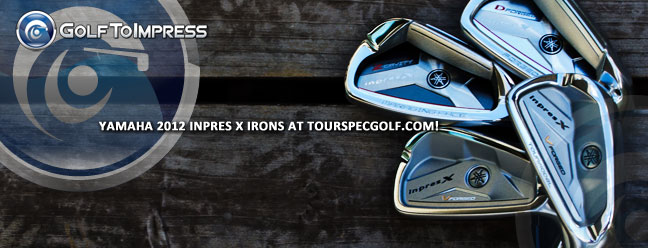
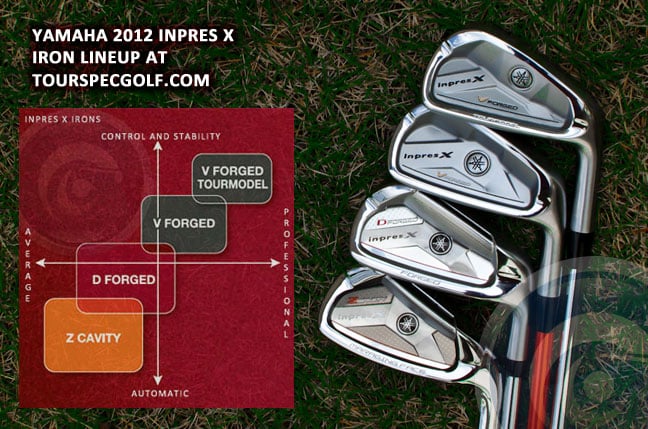
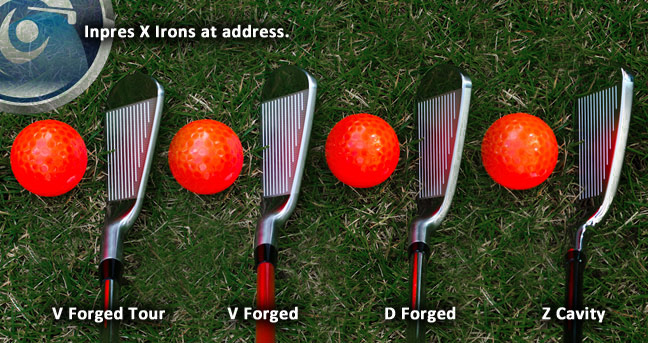
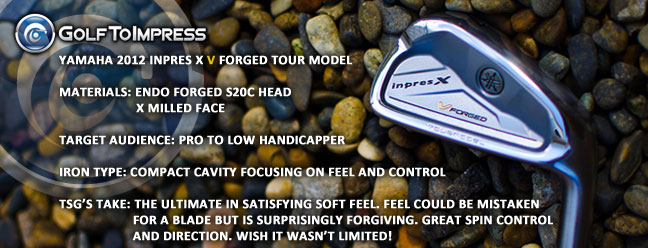
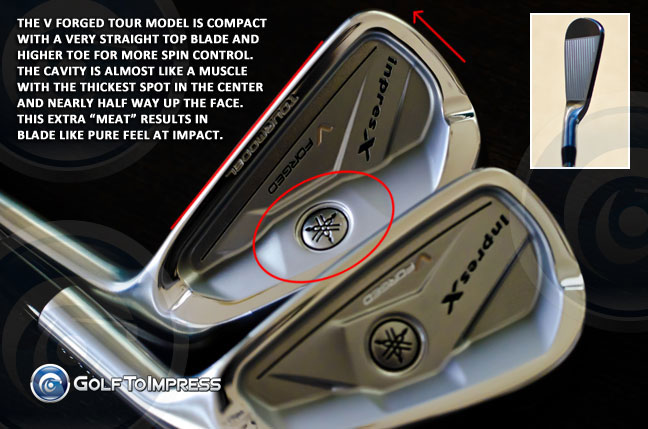
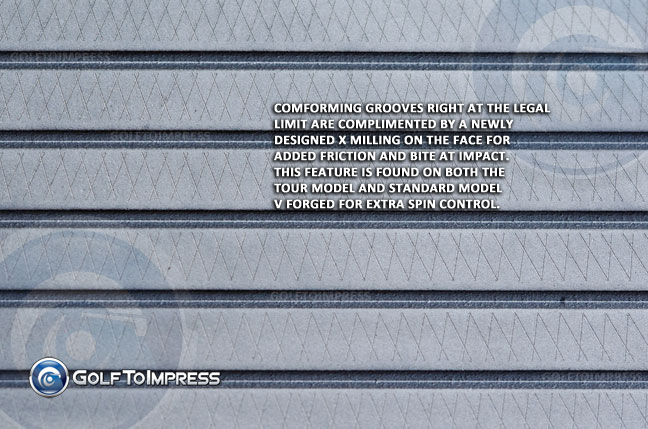
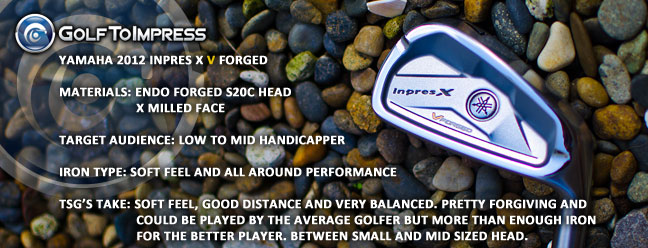
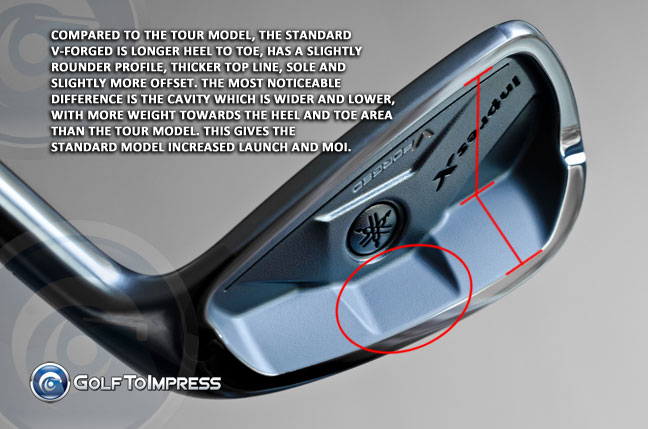
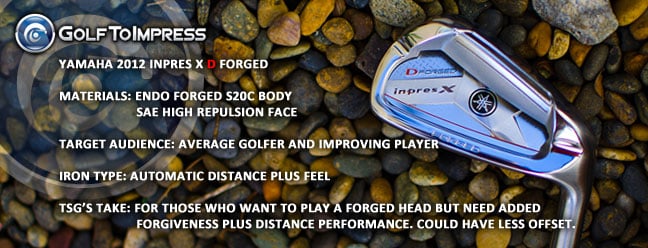
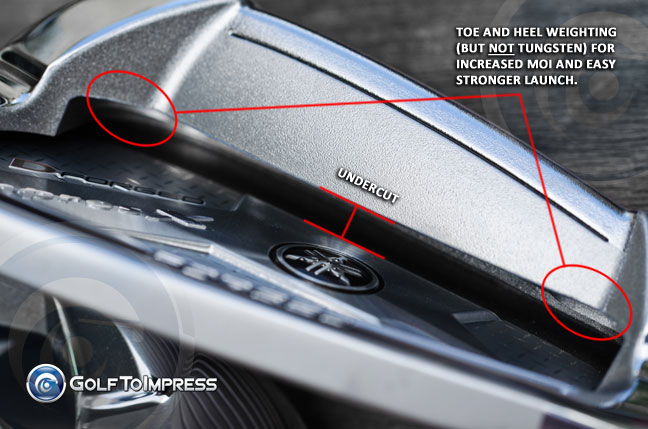
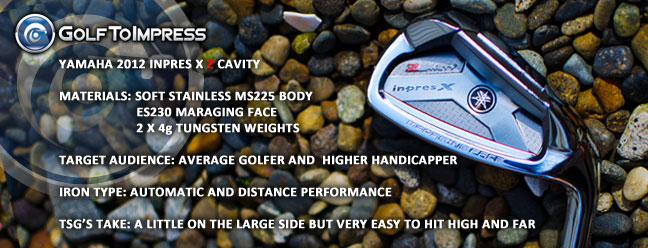
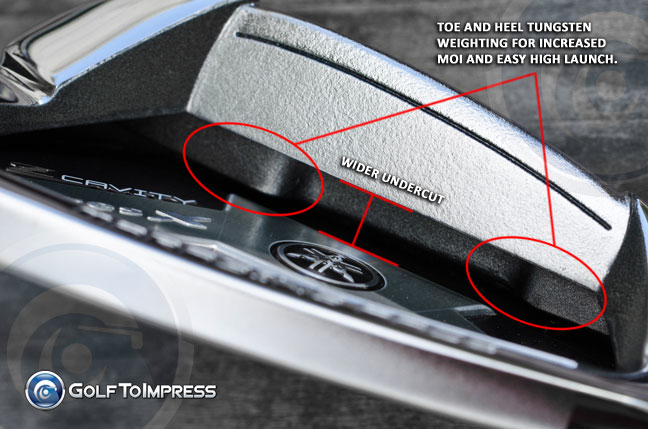
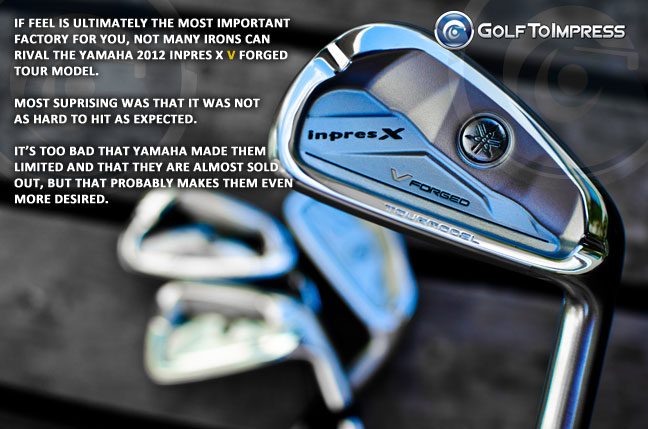










T,
A great informative review! How would the Tour Model compare to the Epon 302s feel wise? Also, are the width of soles wider than previous releases?
The tour model is more compact than the AF-302 and I felt it was softer as it has more muscle in the back than the AF-302 which is a very soft iron in its own right.
I didn’t have the previous tour model here to compare but I’d say the tour model sole width was the same and the standard v Forged may be a tad wider.
Can you compare the v forged vs onoff forged more. Which one is more forgiving? Was planning on getting the onoffs until I read this review. The Yamaha’s sure do look nice.
Really looking forward to a shoot out with the Tours and my AF302’s. I just wish I could figure out what shaft I want to use.
I’m actually gaming the ONOFF Forged now and they are very comparable. Both have very similar qualities, endo S20C forged, good distance, great feel and reasonably good ease of use and forgiveness… I’d say its a toss up right now.
I’d say something that produces great feel. Are you considering graphite or steel?
Aren’t you a club short with the Yam’s though T?
@JCMB
With the tour model yes but that’s because I am used to playing much stronger lofted irons and lighter and longer shafts. The tour model compared to the other 2 average golfer models is 3 degrees weaker an 0.75″ shorter which results in the one less club distance. I think it’s to be expected considering these differences.
I should note even the standard V forged is 2 degrees stronger. And with a 75g graphite shaft vs the s200 in the tour model.
Is there a big difference in workability between the tour and the standard v forged/onoff forged models?
There is some difference certainly as the Tour model just has more touch and direction as well as the higher toe for working the face and more spin control.
That said the standard model is also workable ie fade and draw though not quite as much as the Tour.
Regarding the D series, would the undercut cavity show on the 4 or 5 iron when addressing the ball?
Henry, yes it will be visible especially with the stronger lofts.
Can your compare Iron Inpres x Z cavity 2012 with Iron Inpres X Classic 2010…? thanks
Can you tell me, the Yamaha tourmodel, come in parrallel or tapper tip?
Which would the better option for the average golfer?Your Message@gocchin:
Taper tip.
The D-forged would be the best all around for the average golfer but then again it depends on the individual. The average golfer could play anything from Z Cavity to V Forged depending on how good their ball striking is.
Your Message
I am a 14 Hcp player, at present playing with Taylormade R9 max E graphite iron. My 7 iron distance carry +- 130meter. Which Yamaha iron do you recommend. I need more distance and forgiveness.
I
when arrive in Indonesia. how much this price…?
I need to bye full set of Yamaha golf
Hi,I bought a set of Z cavity Irons and fit them with Fubuki 60 regular shafts.I am 77 years old and has a handicap of 20.I find that I hit better with weight on my right foot instead of the left foot.Can you shed some light on this.As I am playing better now with the Z cavity set.
CSK
I own a set of the D forged irons fitted with 950GH Regular shaft. As compared with the 850GH Regular shaft which are 11gm lighter, what are the other differences in terms of feel, control, etc? Thank you.
The 850GH has a slightly narrower butt than the 950 and coupled with slightly higher torque and naturally less flex, this equals a very easy to swing shaft that is easier to load than than the 950GH. I personally prefer the 850 and 750 over the 950.
could you review the yamaha iron clasic 2012.. many thx